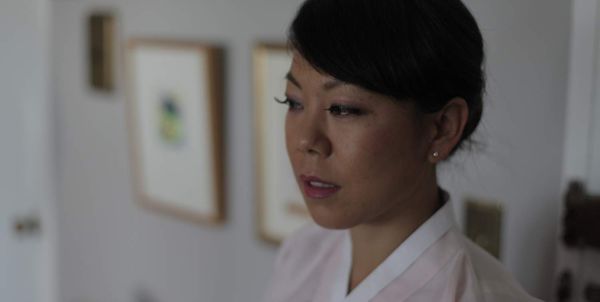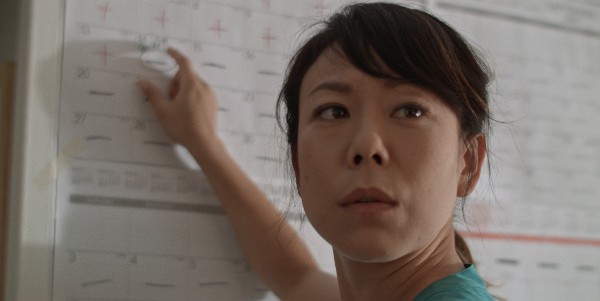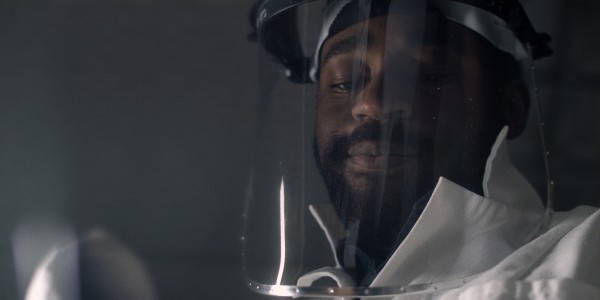Jacob Akira Okada & Carlyanna Taylor Discuss The Future Of Families & ANYA

Jim Dixon retired from practicing law not a moment too…
Anya is a contemporary, science fiction love story based in New York, about a couple whose determination to have a child leads them to a cutting-edge geneticist who tries to help them, no matter the cost, an ancient outlier community hiding in plain sight in New York City, and ultimately, a life-changing question: are they willing to have a gene-edited baby, no matter the cost? Inspired by futuristic and sometimes chilling developments in the worlds of anthropology and genetics, Anya invites viewers to explore issues surrounding the development of genetic technologies, and the struggles of creating a family in a world where the definition of family is evolving.
Anya, a Taylor/Okada film under their First Encounter Productions banner, is the first narrative feature of filmmaking partners Jacob Akira Okada and Carylanna Taylor, Ph.D. The two spoke exclusively about their new film with Film Inquiry.
Jim Dixon for Film Inquiry: I’d like to talk about your new film Anya. I was struck by a number of things. This is a this is a relatively quiet movie, and yet you’re very definitely treading on the same ground as Mary Shelley.
Jacob Akira Okada (to Carlyanna Taylor): Frankenstein.
Sorry, I’m an English major—you’re a scientist. But I was fascinated with some of the ethical dilemmas you touch on in the movie. How difficult was it to build a story around such a message or theme-oriented premise?
Carlyanna Taylor: I think maybe we should both answer this, since I think it’s going to be a little bit different for each of us—I would say that we didn’t set out to build it on that premise. When we were writing Anya, we were wrapping up the edit on our first documentary together, which is Painting the Way to the Moon, and one of the things that really fascinated us about working on the documentary was just how science is done, and how some sometimes a very accidental discovery can turn into something major—how sometimes the very messy process of scientific research that involves a lot of people, a lot of research participants, can get moved from doing a narrative about one person’s brilliant discovery.
And coming from anthropology, I have a lot of like on-the-ground experience trying to interact with individuals and also a community, to gain some kind of consent in the research process to go forward, and I know that even within a family there can be very heterogeneous opinions—very, very different opinions on whether someone should go forward on the research project, let alone in a community. It was coming more from the territory of wanting to take people inside moments of unexpected discovery, and what that might feel like from the researcher and the research participants’ standpoint.

Jacob Akira Okada: Well, I know I would also add that just from a creative perspective, we were interested in starting a story with a “what if” premise—what if a couple was infertile and, they discovered some weird genetic difference that was not just one person, but that specific group of people and what would that mean for that group of people if they partially built their culture around their difference, their inability to procreate with the general population. So this group of people thinks they’re distinct, and they’ve built a culture around it, and what would that culture be like, and what would the rules of the culture be like and how they would hide in plain sight in the different communities they lived in. And we know lots of communities living in New York City who do hide in plain sight, have their own languages, distinct cultural beliefs and histories. For us, it was kind of a fun “what if” experiment. And then the ethics, the ethical questions, around whether this scientist who kind of stumbled upon a big discovery, what choices he made as a scientist—those came afterwards, but they were very interesting to us, and became more front and center as we worked hand-in-hand with our science advisors.
I don’t want to drop too many spoilers, but you do have this interesting dynamic in the movie where at first we’re inclined to write off the Narvals’ belief that they’re cursed if they marry outside their culture or their community as some kind of a superstition or a myth, but then it turns out that it’s actually based in a scientific reality. Now we’re dealing with a religion versus science tension which has existed from time immemorial. I am not a scientist or an anthropologist, but the question that floated through my mind is that if you’ve got a small community like this, that literally cannot breed outside of their own community, wouldn’t this society be in danger of all the bad things to go with inbreeding?
Carlyanna Taylor: You’ve identified one of the quandaries Seymour [Motell Gyn Foster] faces and brings up the end. We actually consulted a population geneticist at one point in the writing of the film, because we realized that the normal population has to be a certain size to even be sustainable and not collapse on itself from lack of genetic diversity within the population. And you see that with certain cultural groups in our world, like among European royalty, if they’re intermarrying so much that they’re spreading hemophilia.
Like the last Czar of Russia.
Carlyanna Taylor: Yeah. You can mention these people’s vulnerabilities and propagate different vulnerabilities and you’re not getting the infusion of diversity. So that’s the problem that any small population has, whether they’re validated by culture, bounded by genetics and for the or the not of all the way they handle it is cultural adaptation. So they make these childhood engagement, which you see in the main character was engaged as a child through an arranged engagement and so they intend to marry him into another family line so that they’re not dealing with inbreeding, basically prisoner marriage. And they develop the courage to keep people at home. So there’s kind of ways—
Jacob Akira Okada: —cultural ways—
Carlyanna Taylor: —to adapt to this like biological reality for them.
It’s an extreme example of what I observed growing up in Schenectady, New York back in the seventies. We had a very significant Italian-American community, and it could be pretty insular.
Carlyanna Taylor: Sure.
I mean if a kid from one of the Italian-American families brought home a boyfriend or a girlfriend who was not Italian, you might find that some of the myths about Italian grandmothers weren’t that mythical.
Carlyanna Taylor: I think cultures deal with this a lot with rules of marriage. Can you marry a first cousin, or a second cousin cousin, or a third cousin? Do you marry within your tribe, or do you have to go to a different tribe to marry? I think that’s just a kind of a millennia-long way of coping with maintaining genetic diversity. People might not have consciously realized that’s what they were doing, but on some level they do know that if we do this, we avoid having certain kinds of certain diseases. People do more science than they realize in their day to day lives, I think.

You’ve piled a lot of challenges on your main characters in this movie. Just to begin with, they’re dealing with all the challenges that any mixed ethnicity relationship is going to run into. And then the character Marco (Gil Perez-Abraham) is from a particularly exotic culture that raises these unique issues we’ve been discussing. How important was the issue of casting was to creating that dynamic on film.
Jacob Akira Okada: Yeah, great question. I think they’re clearly attracted to each other, so there’s that important surface bond. I don’t want to call it surface—it becomes something deeper, more intimate—but running parallel to that there are extreme cultural differences. And sometimes those differences will evolve into deeper understanding. And I think that’s eventually what happens in this story, but sometimes it’ll tear intercultural couples apart.
In my own personal experience, my mom is from Romania, and my dad is Japanese American, and they couldn’t be more different. They’ve been married for some forty odd years, and they’re probably still negotiating or figuring out what they really mean when they talk to each other.
Carlyanna Taylor: Give the example of “No.”
Jacob Akira Okada: Sure. So my mom asks my father to do something over the years, you know, she’d say, “Can you do X?” Or “Can you do Y?” And my dad would say yes, but he would mean no. In Japanese culture, like just saying no, directly—it’s just not done. But you could say no by saying yes in Japanese culture, and it’s understood contextually. So my father was really saying no, but you but to my mother’s ears, he was saying yes and so you could imagine how that would cause a lot of consternation.
Libby [Ali Ahn] and Marco, come from these two completely different backgrounds, and in the beginning it’s a mutual attraction and curiosity and there is this little scene when they’re in bed after they sleep together and Marco is just in his own world, like his world is expanding and he’s tired from having sex. He says he’s an orphan to or something like to that effect and Libby just, you know, fills in the blanks, and hears what she wants to hear.
And then you know there are some elliptical moments like right before Libby has a miscarriage or Libby asks Marco what religion he is, and he just says “Oh nothing” and plays with a stuffed animal just to distract her. So, those are kind of little beats for the actors to kind of communicate how people lie to each other. And then even later on when after Libby sees Seymour, and she’s deciding if she wants to write articles about her experiences with this new community, and then she goes back and sees Marco and Marco asks, “Oh, you were with Seymour,” and she says, “No, no, I wasn’t I was visiting your mom,” or whatever and she’s lying. That just happened very fluidly, but the lie was a choice on Libby’s part.
Carlyanna Taylor: The movie was cast as it was written—There was an intentionality behind the age and the ethnicity and really mostly the curiosity and the intelligence of the characters to that we brought into casting. We worked with two wonderful casting directors who worked with us to find really talented actors who could embody the roles and also feel at home filming in the streets of New York and feel at home while filming alongside non-actor extras. All the Narvals were cast from Jackson Heights in Queens.
How did you decide on what the Narvals would look like and how did you how did you arrive at the specifics of their culture?
Jacob Akira Okada: Ah, great question.

Carlyanna Taylor: Yeah, Jim. So it’s kind of working backwards. For there to be a genetic variant among an entire population like that, they had to evolve in isolation, which usually means geographic isolation, right? So we placed them on an island. And because of my experience working in Latin America, we chose an island in the Caribbean off the coast of Colombia.
So this would be a group that arrived in on this island long before the Spanish came to the Americas—we’re talking like thousands and thousands of years ago—and spent their time fishing and hunting and living—farming there. The genetic variant develops and gets shared among them over time, and eventually becomes so common that everybody has it, and when the Spanish arrive, they can’t have children with the outside, with the Spanish.
A lot of their culture that we see on screen develops from that encounter…In the 20th century, some of them would move to New York like migrants from Latin America…searching for better opportunities, searching for economic opportunity…But biologically they should all look like Native Americans, right? …But finding that cast on a budget, would have been incredibly difficult and also would have put more of a label on the group than we wanted…So we had to invent this whole backstory of Viking shipwreck. Not that anyone notices, except us.
I gather the two of you were co-creators in every way, and as someone who does not play well with others, I’m always fascinated with how that works.
Jacob Akira Okada: Well, we most certainly co-wrote.
Carlyanna Taylor: The story came through a conversation over breakfast one morning, and we kept the conversation going that day. And like, by the end of the day, we had the central story and the main three characters invented. And we kind of laid it out together on cards, and one of us jotted down the first draft of the script and when we had like something on paper, we both jumped into writer duet, kind of tumbled over each other… I think the main thing was that we would write it together, like in real time together.
Jacob Akira Okada: So it was a constant dialogue. And then in terms of the casting, it was just same thing working together in tandem, and just talking. And then on set I was directing the actors so that it was simpler—you know, it was simpler to have one point of reference. Carlyanna was really producing on the set.
And since we had such a small crew, it was like sometimes she was line producing, sometimes she’s production designing, like we’re on the train and she’s laying the tracks right in front of us. And then in terms of post, she did like all the assistant editing, synching, labeling everything and organizing spreadsheets of all the different takes and things like that. And then even the first assemblies. I have a day job story producing which is essentially editing TV shows, and no, I didn’t have I didn’t have time to edit, except for nights and weekends.
So, Carlyanna did the first assembly, and then once she’d brought the whole film together, I was able, like on weekends, to cut things down and tighten them. And then we both worked on the structure, because this is a low-budget film, you know, like there are certain scenes like we couldn’t film that we had written. You’re rewriting the movie as you’re editing. So there are significant changes that we made to make the film the best film we could with what we actually had.
I’ve occasionally tried to explain to fledgling screenwriters that “No, see that’s not actually the movie…”
Carlyanna Taylor: (laughs)
Jacob Akira Okada: (laughs) No, not even close.
So how did you find financing for your film?
Jacob Akira Okada: Oh, we had one investor who put up about 20% of the production budget and the rest of it was self-financed.
Carlyanna Taylor: Through our freelance work—
Jacob Akira Okada: —Story producing.
You have found a distributor—where will audiences be able to see Anya?
Carlyanna Taylor: So Anya is available now on demand, and through iTunes/Apple TV. Since November 26th, it’s on demand on Apple, Amazon, Google Play, Vimeo, X-Box and DVD. We have a smattering of screenings too, that we keep adding to. The best place to go to is Anyamovie.com to see where we’re coming.
I’m glad it’s going to be seen. What’s up next for you?
Carlyanna Taylor: We each have projects that we’re working on, and kind of serving as the editor for the other. Jacob can talk about his. Mine is a an immigration project based on my research in Honduras with a Honduran transnational family. It’s a story about a young a young girl who is very close to her grandfather and witnesses his murder, and has to decide whether to stay in the community she loves and fight for survival there, or run for the relative safety of her father in New York. So that’s the project I’m working, on first as a novel, and then adapt it into a screenplay.
Jacob Akira Okada: Yeah, I’m working on a story about gentrification and how like a building in New York City is fighting for survival after people are coming into the neighborhood to change it. So, we are approaching a bit differently in the sense of like, Carlyanna is taking the lead on the Honduran project, and I took the lead on the gentrification thing, but we’re each collaborating on both, just kind of serving like a sounding board and she is serving as a sounding board.
Best of luck with each of your projects and with Anya.
Film Inquiry would like to thank Jacob Akira Okada: and Carlyanna Taylor for taking the time to speak with us.
Anya was released in the USA on November 26, 2019.
Does content like this matter to you?
Become a Member and support film journalism. Unlock access to all of Film Inquiry`s great articles. Join a community of like-minded readers who are passionate about cinema - get access to our private members Network, give back to independent filmmakers, and more.
Jim Dixon retired from practicing law not a moment too soon, and now works as a freelance writer and film critic. A lifelong and unrepentant movie geek, he firmly believes that everything you need to know in life you can learn at the movies. He lives in upstate New York.













